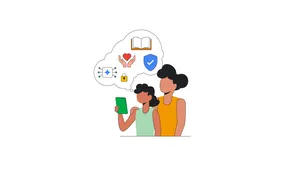5 ways Google for Education helps teachers and students stay safer online

Today is Safer Internet Day, a global initiative promoting a safer and more responsible online experience for everyone, especially children and teens. To mark the occasion, we’re sharing five ways Google for Education supports online safety for teachers and students — from data protection with Google Workspace for Education, to built-in security features on Chromebooks.

1. Data protection for Google Workspace for Education accounts
School-issued and personal Google accounts are completely separate. In fact, with Google Workspace for Education accounts, all user data is owned and managed by the organization, not Google. And education administrators are in charge: They can use tools to manage what students see and do online, including blocking inappropriate content and apps.
2. Secure collaboration with Google Workspace for Education and Chromebooks
Students use school-issued accounts to access Google for Education, which integrates ad-free Google Workspace for Education core services like Google Classroom, Docs, Slides and Gmail. Google for Education products and services continuously protect users, devices and data from increasingly complex threats like ransomware attacks. And Workspace provides admins with tools such as alert and security centers, identity and access management, and data loss prevention.
3. Built-in security with Chromebooks
With verified boot, automatic updates and 256-bit AES encryption (the National Institute Standards & Technology recommended standard), Chromebooks have security built in. They’re designed to create safer digital learning environments, all managed at scale by education administrators and compliant with local and country-wide regulations. With Chrome Education Upgrade and Google Admin console, admins can set policies to filter inappropriate content, restrict app installations and enforce safe browsing practices.
4. More layers of security with third-party apps and monitoring tools
Educators can use tools like Lightspeed or GoGuardian to create digital guardrails, fostering a safer learning experience. You can find more apps that integrate with Google for Education on the Google for Education App Hub.
5. Digital wellbeing and online safety tools
An important part of online safety is teaching students how to be safe online, made easier with programs like Be Internet Awesome. For Safer Internet Day, we’ve released a special edition of Highlights Magazine based upon the curriculum. Teachers can download a free digital version of the magazine and supplementary materials at Highlights.com/InternetSafety.
Admins and educators can check out our website for more resources on digital safety. That includes the K-12 Cybersecurity Guidebook, which outlines tools and best practices specifically designed to support safe and effective technology use in schools. And parents and guardians can learn more about the tools their children are using in school in our Guardian's Guide and Families FAQ.






